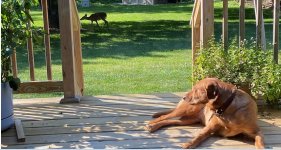To sum up an hour long video or a chapter of a training book, or weeks or months of training, in one paragraph.
1. Associate the collar with fun. I put the collar on at a young age, any training or hunting session. But it's not turned on for months, until all the building blocks are in place to use it.
2. Basic obedience has to be 100% instilled into the dog. They know the commands you (or trainer) has been working on.
3. Once you start using the collar, you are providing stimulation which makes the dog uncomfortable.
4. You need to teach the dog how to turn off the stimulation.
5. Apply light stimulation, say command (sit), dog sits, then stop stimulation.
6. The dog will learn that listening to command or doing the proper thing will turn off the stimulation.
If you have a dog that is chasing deer and not collar conditioned, and you are just zapping them. They are going to be beyond confused most of the time and you could ruin a few things. All of training is like a series of building blocks. Just like school. You can't get your dog to middle school (collar conditioning, force fetching) by skipping elementary (basic obedience), or advancing right to high school (very advanced training, retrieves, marks, points, etc.).

